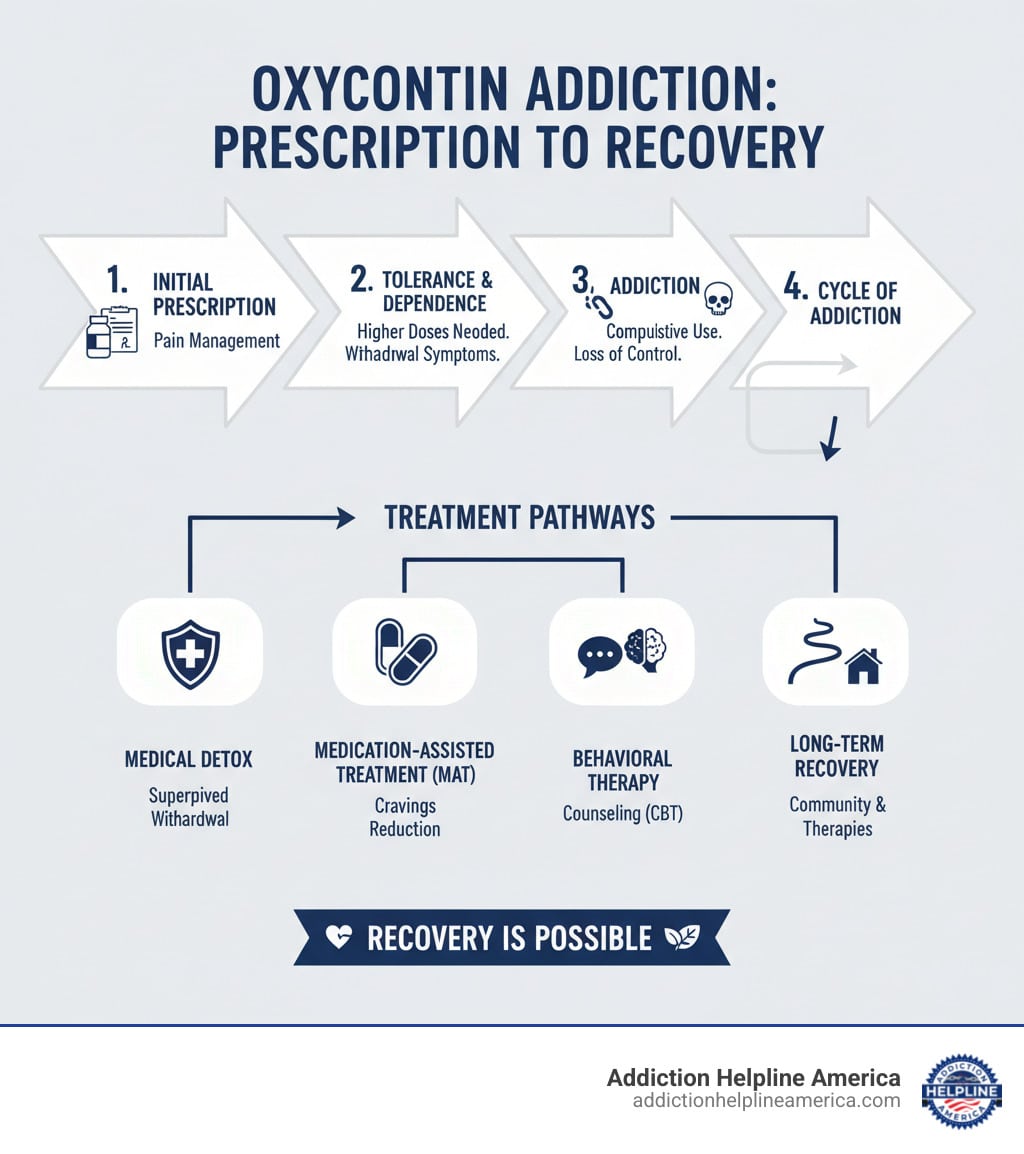Your Journey to a Healthier Life Starts Here
Free Insurance Verification
Verify Your Treatment Coverage
Verify Your Treatment Coverage
Oxycontin Addiction Treatment offers a path to recovery for those struggling with dependency on this powerful prescription opioid. Key treatment options include:
Core Treatment Approaches:
OxyContin, a sustained-release form of oxycodone, was designed for long-lasting pain relief but has become a central player in the opioid crisis due to its high potential for abuse. What starts as legitimate pain management can quickly spiral into addiction. Research shows about 25% of patients on long-term opioid therapy develop an addiction. Furthermore, 78% of OxyContin users in treatment obtained the drug from non-prescribed sources, with 86% using it to “get high.”
The good news is that recovery is absolutely possible. Oxycontin addiction is a treatable medical condition. With the right combination of medical care, therapy, and support, thousands of people overcome this dependency every year.
Addiction Helpline America guides individuals and families through the complexities of Oxycontin Addiction Treatment, connecting them with evidence-based programs. Our team provides personalized, confidential support 24/7 to help you find the right treatment for your unique situation.
This guide covers everything from how addiction develops to exploring comprehensive treatment options and building a support system for long-term success.

Understanding how OxyContin addiction develops is the first step toward treatment. As a brand name for the powerful opioid oxycodone, it’s prescribed for moderate to severe pain. While effective, its properties also make it dangerously addictive.
The drug works by attaching to opioid receptors in the brain and body, blocking pain signals and changing how the brain experiences pleasure and reward.
When OxyContin binds to opioid receptors, it floods the brain with endorphins, creating an intense sense of euphoria. The brain’s reward system learns to associate the drug with this powerful, artificial pleasure.
With repeated use, the body adapts. The brain produces fewer natural endorphins, and opioid receptors become less sensitive—a process called tolerance. This requires higher doses just to feel normal, let alone euphoric.
This is not a matter of willpower. As researchers Pathan and Williams note in “Basic opioid pharmacology: an update,” these receptor-level changes are the biological foundation of addiction. The body becomes dependent, and the brain craves the drug. This is why Oxycontin Addiction Treatment requires medical expertise to address these fundamental changes in brain chemistry.
Recognizing OxyContin abuse can be difficult, as the line between use and addiction blurs over time. Key warning signs include:
Anyone can develop an addiction, but certain factors increase vulnerability:
It’s crucial in Oxycontin Addiction Treatment to distinguish between physical dependence and addiction.
Physical dependence is a physiological adaptation to a drug. If someone stops taking it, they experience withdrawal symptoms (e.g., sweating, anxiety, muscle aches). This can happen even when using the medication as prescribed for legitimate pain and does not automatically mean they are addicted.
Addiction (Opioid Use Disorder) is a chronic brain disease characterized by compulsive drug-seeking and use despite severe negative consequences. It involves changes in brain circuits related to reward, stress, and self-control. The key difference is the loss of control and continued use despite harm. While physical dependence is part of addiction, it can exist without it. Effective treatment must address both the physical and psychological components.
Effective Oxycontin Addiction Treatment is a personalized process that heals both body and mind. There is no one-size-fits-all approach; treatment plans must be custom to the individual.
Let’s review the primary treatment methods for OxyContin addiction.
Detoxification is often the first step, safely clearing OxyContin from the body. Stopping suddenly triggers intense withdrawal symptoms: severe cravings, diarrhea, vomiting, bone and muscle pain, cold flashes, and overwhelming anxiety.
While rarely life-threatening, these symptoms are so miserable that many people relapse just to stop the discomfort. This is dangerous, as tolerance drops quickly, increasing overdose risk.
Medically-supervised detox is crucial. Healthcare professionals monitor vital signs and use medications like lofexidine to ease withdrawal symptoms, making the process safer, more bearable, and more likely to be completed. You can learn more about what to expect in our guide on Suboxone Withdrawal Symptoms.
MAT is the gold standard for treating opioid use disorder. It combines FDA-approved medications with counseling to address both the physical and psychological aspects of addiction.
These medications are not “trading one addiction for another.” They are therapeutic tools that normalize brain chemistry, reduce cravings, and block the euphoric effects of opioids without producing a high. This provides the stability needed to focus on therapy and rebuilding one’s life.
Medication addresses physical cravings, but behavioral therapies teach you how to cope with life’s challenges without drugs.
As detailed in our article on Holistic Drug Rehab, many programs also incorporate practices like yoga, meditation, and nutritional counseling.
The right level of care depends on addiction severity, co-occurring mental health issues, and one’s home environment.

Our guide on Drug Rehab: Inpatient vs Outpatient offers a detailed comparison. The most important thing is to start. Finding the right fit is the first step toward reclaiming your life.
Lasting recovery from OxyContin addiction is a journey, not a destination. It is absolutely possible when the right support systems are in place.
The reality of Oxycontin Addiction Treatment often differs from common narratives. Research reveals key facts:
These statistics show that treatment must be comprehensive. The typical person seeking help is often older, employed, and reports significant family and psychiatric problems, underscoring the need for integrated mental health care.
Despite the challenges, the prognosis for recovery is genuinely positive with evidence-based treatment. Opioid use disorder is a manageable chronic disease, similar to diabetes or heart disease. As we discuss in our article on the Impact on Life, addressing addiction leads to positive changes in all areas of life.
If you love someone with an OxyContin addiction, your support can make a tremendous difference. Here’s how to help:
Our Help a Drug Addict: Support Recovery Guide offers more detailed strategies for families.


Take the first step towards a healthier life! Call now to connect with our compassionate team and start your recovery journey today. Your path to healing awaits!
Our recovery specialists are available 24/7 to provide support, and all calls are confidential and free. Reach out anytime – we’re here to help!
Healthcare professionals play a critical role in both prevention and treatment.
Prevention involves responsible prescribing practices, such as limiting opioid prescriptions for acute pain and exploring non-opioid alternatives first. Educating patients on addiction risks, safe storage, and proper disposal of unused pills is also vital. Screening for addiction risk factors can help identify vulnerable patients.
Treatment involves referring patients to appropriate Oxycontin Addiction Treatment programs, prescribing MAT medications like buprenorphine, and safely managing withdrawal. For reliable medical information, you can explore resources like Information about opioid addiction on MedlinePlus.
With professional treatment, family support, and personal commitment, thousands of people successfully overcome OxyContin addiction every year.
Here are answers to some of the most common questions we hear about OxyContin addiction.
OxyContin and heroin affect the brain in very similar ways, binding to the same opioid receptors and causing euphoria, dependence, and severe withdrawal. Many people who start with prescription opioids transition to heroin because it is often cheaper and more accessible.
The main differences are origin and safety. OxyContin is a pharmaceutical product, while heroin is an illicit drug with unknown purity and potency. Street drugs are often laced with fentanyl, a synthetic opioid 50-100 times more potent than morphine, which dramatically increases overdose risk.
Despite these differences, the same evidence-based treatments, including MAT and behavioral therapies, are effective for addiction to both substances.
Opioid use disorder is a chronic disease with far-reaching consequences that worsen over time. The long-term effects include:
Comprehensive treatment can reverse these negative trajectories. As detailed in our article on the Impact on Life, recovery is about healing all dimensions of your life.
No, this is a common misconception. Medications used in Oxycontin Addiction Treatment, such as methadone and buprenorphine, are not a substitute addiction. When prescribed correctly, they do not produce a “high.”
Think of it like a person with diabetes taking insulin. These medications are a medical treatment for a chronic disease. They work by stabilizing brain chemistry, eliminating withdrawal symptoms, and reducing the intense cravings that make recovery so difficult.
This stabilization allows a person to engage fully in the counseling and behavioral therapies that are a mandatory part of Medication-Assisted Treatment (MAT). Research clearly shows that MAT improves treatment retention, reduces illicit drug use, and significantly lowers the risk of fatal overdose. These medications give the brain a chance to heal while you do the work of recovery.

If you’re reading this, you’ve already taken the courageous first step of seeking information. We want you to know that recovery from OxyContin addiction is absolutely possible, and you don’t have to do it alone.
Addiction is a treatable medical condition, not a character flaw. Like any other chronic disease, it requires professional treatment and support. Thousands of people overcome opioid addiction every year and go on to live joyful, meaningful lives.
At Addiction Helpline America, we help individuals and families steer the complexities of addiction treatment. We understand that every situation is unique, so we take the time to connect you with a program that’s right for you.
Our services are free, confidential, and available 24/7. Whether you need information on detox, MAT, or different levels of care, we are here to help. We work with a vast network of treatment centers and can help you find quality care that fits your needs.
Seeking professional help for Oxycontin Addiction Treatment is one of the bravest decisions you can make. Recovery is about more than stopping drug use; it’s about refinding yourself, rebuilding relationships, and creating a life you don’t need to escape from.
You don’t need to have all the answers. You just need to reach out. Let us help you find the right rehabilitation services for you and start a new chapter filled with hope and healing.
Are you or a loved one struggling with addiction? Call today to speak to a treatment expert.
Calls to any general helpline will be answered or returned by one of the treatment providers listed, each of which is a paid advertiser:
Our helpline is available 24 hours a day, 7 days a week at no cost to you and with no obligation for you to enter into treatment. We are committed to providing support and guidance whenever you need it.
In some cases, Addiction Helpline America charges our verified partner a modest cost per call. This fee helps us cover the costs of building and maintaining our website, ensuring that we can continue to offer this valuable service to those in need.
Calls to the general helpline will be answered or returned by one of the listed treatment providers, all of whom are paid advertisers.
By using the helpline, you agree to the terms of use. We do not earn any commission or fee based on the treatment provider selected by the caller, and there is no obligation to pursue treatment.
This service is not affiliated with Alcoholics Anonymous World Services, Inc.